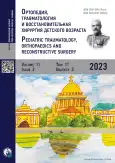Hook nail deformity correction by the combination of the antenna procedure and reverse-flow homodigital island flap: Description of clinical cases
- Authors: Alexandrov A.V.1, Vybornov D.Y.1,2, Goncharuk P.V.1, Evdokimov A.N.1, Idris L.Y.2, Smirnov A.A.1,2, Khagurov R.A.1, Alexandrova N.Y.1
-
Affiliations:
- Filatov Moscow Children’s Clinical Hospital
- Pirogov Russian National Research Medical University
- Issue: Vol 11, No 2 (2023)
- Pages: 201-208
- Section: Clinical cases
- URL: https://ogarev-online.ru/turner/article/view/264675
- DOI: https://doi.org/10.17816/PTORS321717
- ID: 264675
Cite item
Abstract
BACKGROUND: Hook nail deformity is one of the widespread post-traumatic deformities of distal phalanges. The affected finger has decreased function and loses its characteristic appearance. Only a few publications explored this problem in children. In this study, we present a surgical correction technique for this deformity by the combination of two existing reconstructive methods, i.e., the “antenna procedure” and the reverse-flow homodigital island flap.
CLINICAL CASES: A series of clinical cases of patients aged 3, 5, and 17 years who underwent hook nail deformity correction was analyzed. These children underwent the combination of the antenna procedure and reverse-flow homodigital island flap. In all three cases, the deformities were corrected, and an acceptable appearance, and function of the fingers were achieved.
DISCUSSION: Various methods of hook nail deformity correction have proven themselves and affirmed by literature data. The method described herein may be considered reliable, as demonstrated by the clinical cases.
CONCLUSIONS: We consider the combination of the “antenna procedure” and reverse-flow homodigital island flap as a justified method. However, issues raised in this technique require further investigation.
Full Text
##article.viewOnOriginalSite##About the authors
Alexander V. Alexandrov
Filatov Moscow Children’s Clinical Hospital
Email: alexmicrosurg@mail.ru
ORCID iD: 0000-0002-6110-2380
SPIN-code: 5229-0038
MD, Head of the Department of Reconstructive Microsurgery
Russian Federation, MoscowDmitry Y. Vybornov
Filatov Moscow Children’s Clinical Hospital; Pirogov Russian National Research Medical University
Email: dgkb13@gmail.com
ORCID iD: 0000-0001-8785-7725
SPIN-code: 2660-5048
MD, PhD, Dr. Sci. (Med.), Professor
Russian Federation, Moscow; MoscowPavel V. Goncharuk
Filatov Moscow Children’s Clinical Hospital
Email: goncharukpavel@yandex.ru
ORCID iD: 0000-0002-9560-037X
SPIN-code: 6801-9875
MD, surgeon
Russian Federation, MoscowAlexander N. Evdokimov
Filatov Moscow Children’s Clinical Hospital
Email: pediatrix@yandex.ru
ORCID iD: 0000-0002-9113-3612
SPIN-code: 9432-3519
MD, surgeon
Russian Federation, MoscowLamiya Ya. Idris
Pirogov Russian National Research Medical University
Email: idrislamiya@mail.ru
ORCID iD: 0000-0002-4902-7939
SPIN-code: 1193-7787
MD, PhD student
Russian Federation, MoscowAlexander A. Smirnov
Filatov Moscow Children’s Clinical Hospital; Pirogov Russian National Research Medical University
Email: smirnov_aan@bk.ru
ORCID iD: 0000-0002-7274-8291
SPIN-code: 4994-9364
MD, surgeon
Russian Federation, Moscow; MoscowRuslan A. Khagurov
Filatov Moscow Children’s Clinical Hospital
Email: dr.khagurov@gmail.com
ORCID iD: 0000-0001-7944-8438
MD, surgeon
Russian Federation, MoscowNatalya Ye. Alexandrova
Filatov Moscow Children’s Clinical Hospital
Author for correspondence.
Email: docnatali1@yandex.ru
ORCID iD: 0009-0008-7269-0289
MD, anesthesiologist
Russian Federation, MoscowReferences
- Al-Anazi AF. Fingertip injuries in paediatric patients – experiences at an emergency centre in Saudi Arabia. J Pak Med Assoc. 2013;63(6):675–679.
- Patel L. Management of simple nail bed lacerations and subungual hematomas in the emergency department. Pediatr Emerg Care. 2014;30(10):742–745. doi: 10.1097/PEC.0000000000000241
- Miller AJ, Rivlin M, Kirkpatrick W, et al. Fingertip amputation treatment: a survey study. Am J Orthop (Belle Mead. NJ). 2015;44(9):E331–E339.
- Kumar VP, Satku K. Treatment and prevention of “hook nail” deformity with anatomic correlation. J Hand Surg Am. 1993;18(4):617–620.
- Panattoni JB, De Ona IR, Ahmed MM. Reconstruction of fingertip injuries: surgical tips and avoiding complications. J Hand Surg Am. 2015;40(5):1016–1024. doi: 10.1016/j.jhsa.2015.02.010
- Hwang E, Park BH, Song SY, et al. Fingertip reconstruction with simultaneous flaps and nail bed grafts following amputation. J Hand Surg Am. 2013;38(7):1307–1314. doi: 10.1016/j.jhsa.2013.03.032
- Kusuhara H, Ichinohashi K, Sueyoshi Y, et al. Reconstruction of severely crushed fingertip amputations with basic fibroblast growth factor slow release system. Plast Reconstr Surg Glob Open. 2017;5(6). doi: 10.1097/GOX.0000000000001384
- Alexandrov AV, Goncharuk PV, Evdokimov AN, et al. Two clinical cases of the reconstruction of distal phalanges of hand in children by combination of the regional flap and scrap bone and nailbed graft. Pediatric Traumatology, Orthopaedics and Reconstructive Surgery. 2022;10(3):277–284. (In Russ.) doi: 10.17816/PTORS108022
- Atasoy E, Godfrey A, Kalisman M. The “antenna” procedure for the “hook-nail” deformity. J Hand Surg Am. 1983;8(1):55–58.
- Henderson JT, Schulz SA, Swiergosz AM, et al. Preservation of the sterile matrix, hyponychium, and fingertip pad in fingertip reconstruction with composite fingertip and nail bed graft and volar V-Y advancement flap. Eplasty. 2017;17.
- García-López A, Laredo C, Rojas A. Oblique triangular neurovascular osteocutaneous flap for hook nail deformity correction. J Hand Surg Am. 2014;39(7):1415–1458. doi: 10.1016/j.jhsa.2014.04.036
- Alexandrov AV, Smirnov AA, Gonchruk PV. Fingertip defects coverage using reverse-flow homodigital island flaps. Pediatric Traumatology, Orthopaedics and Reconstructive Surgery. 2021;9(2):221–228. (In Russ.) doi: 10.17816/PTORS57059
- Alexandrov AV, Goncharuk PV, Idris LYа, et al. A complex soft tissue reconstruction of distal phalanges in children. Russian Journal of Pediatric Surgery, Anesthesia and Intensive Care. 2021;11(1):27–38. (In Russ.) doi: 10.17816/psaic701
Supplementary files










